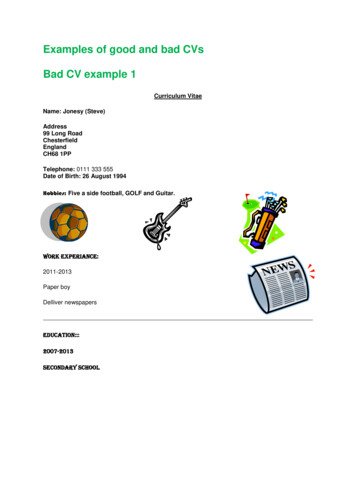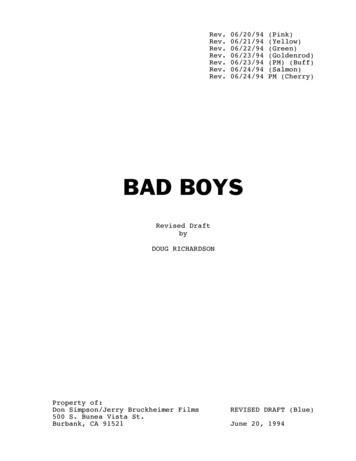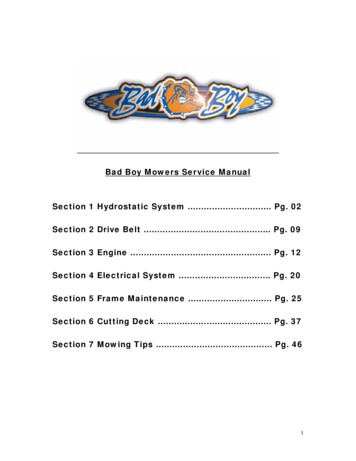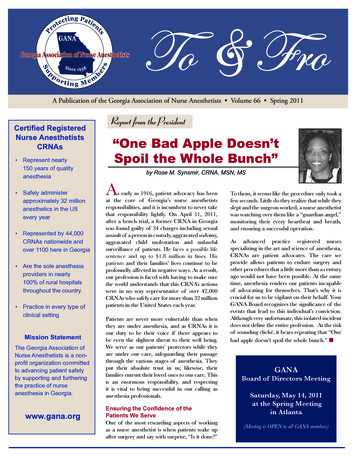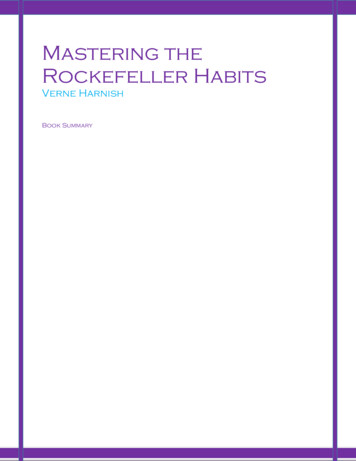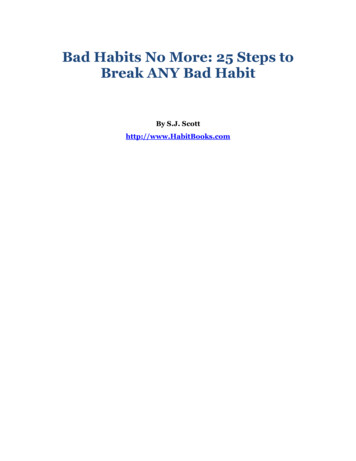
Transcription
Bad Habits No More: 25 Steps toBreak ANY Bad HabitBy S.J. Scotthttp://www.HabitBooks.com
Bad Habits No More Copyright 2014 by Oldtown Publishing LLCAll rights reserved. No part of this book may be reproduced in any form withoutpermission in writing from the author. Reviewers may quote brief passages in reviews.DisclaimerNo part of this publication may be reproduced or transmitted in any form or by anymeans, mechanical or electronic, including photocopying or recording, or by anyinformation storage and retrieval system, or transmitted by email without permission inwriting from the publisher.While all attempts have been made to verify the information provided in thispublication, neither the author nor the publisher assumes any responsibility for errors,omissions, or contrary interpretations of the subject matter herein.This book is for entertainment purposes only. The views expressed are those of theauthor alone, and should not be taken as expert instruction or commands. The reader isresponsible for his or her own actions.Adherence to all applicable laws and regulations, including international, federal, state,and local governing professional licensing, business practices, advertising, and all otheraspects of doing business in the US, Canada, or any other jurisdiction is the soleresponsibility of the purchaser or reader.Neither the author nor the publisher assumes any responsibility or liability whatsoeveron the behalf of the purchaser or reader of these materials.Any perceived slight of any individual or organization is purely unintentional.
Your Free GiftAs a way of saying thanks for your purchase, I’m offering a free report that’s exclusive tomy book and blog readers.Lifelong habit development isn’t easy for most people. The trick is to identify whatyou’d like to fix and create a step-by-step strategy to make that change. The key is toknow where to start.In 77 Good Habits to Live a Better Life, you’ll discover a variety of routines that can helpyou in many different areas of your life. You will learn how to make lasting changes toyour work, success, learning, health and sleep habits.This lengthy PDF (over 12,000 words) reviews each habit and provides a simple actionplan. You can download this free report by clicking here.http://www.developgoodhabits.com/FREE
Table of ContentsBad Habits No More: 25 Steps to Break ANY Bad HabitYour Free GiftTable of ContentsWant to Break a Bad Habit?The Myth of WillpowerPART I: LAYING THE FOUNDATION FOR A HABIT CHANGEStep #1: Know the Difference between Bad Habits and AddictionsStep #2: Focus on One Habit at a TimeStep #3: Commit to a 30-Day Habit ChallengeStep #4: Set a Start DateStep #5: Identify the Target GoalStep #6: Avoid Cold Turkey SolutionsStep #7: Set a Baseline MetricStep #8: Create Incremental Goals (Optional)PART II: UNDERSTAND YOUR HABIT LOOPStep #9: Identify the Habit RoutineStep #10: Record the Habit TriggersStep #11: Try Different RewardsStep #12: See What WorksStep #13: Create an “If-Then Plan”Step #14: Use “Habit Reminders” to Stay ConsistentPART III: BUILD A SUPPORT SYSTEMStep #15: Keep an Accountability JournalStep #16: Make a Public DeclarationStep #17: Find an Accountability PartnerStep #18: Ignore the Naysayers
Step #19: Avoid Trigger LocationsPART IV: OVERCOME CHALLENGESStep #20: Maintain a Healthy Lifestyle and AttitudeStep #21: Beware the “What-the-Hell Effect”Step #22: Practice StreakingStep #23: Forgive YourselfStep #24: Celebrate “Small Wins”Step #25: Focus on the Journey, Not the DestinationFinal Thoughts Would You Like to Know MoreDid You Like Bad Habits No More?More Books by Steve
Want to Break a Bad Habit?Habits run our lives. Much of what you do is based on a habit you’ve developed at somepoint in your life. In fact, according to a 2006 study conducted at Duke University, over40 percent of what you do on a daily basis is habitual. In other words, you oftencomplete the same actions, in the same place and at the same time.Many habits are helpful, like eating healthy, exercising regularly and giving that “secondglance” before switching lanes in a car.Other habits are harmful, like smoking, drinking excessively or spending too much timeon the Internet.You might consider these routines to be nothing more than small hindrances, but somecan have a long-term, debilitating impact on your life.Since you’re reading this book, I’ll assume you want to break a specific bad habit. Oddsare, you’ve tried in the past and maybe you were successful for a few days. Thensomething unexpected came up where you slipped for a day or two. One mistakesnowballs into a series of setbacks. Eventually you give up on the idea of making a habitchange simply because it’s too difficult to do.The interesting thing?We’ve all experienced this pattern at some point in our lives.You want to change a behavior, yet you keep experiencing failure. It doesn’t mean you’relazy or weak-willed. It means you didn’t have the right tools for making a lasting habitchange.What you need (and what the following book provides) is a strategy for identifying yourworst habits and learning how to overcome them. I call it Bad Habits No More: 25 Stepsto Break ANY Bad Habit.This book wasn’t written to lecture you about your mistakes. Nor is it designed to fillyour head with rah-rah motivational nonsense where I tell you to simply “try a littleharder.” Instead, we’ll talk about how to understand the whys behind a negativebehavior and how to build positive habits to help you overcome it.As you’ll see, I don’t believe in the idea of “white-knuckling” your way through abehavior change. This strategy rarely works because it doesn’t teach you how to copewith temptations and moments of weakness.Another thing you’ll discover is the underlying psychology behind your bad habit. Youperform every action for a specific reason, but rarely do you take the time to fullyunderstand your behavior. With this book, you’ll learn how to explore your feelings
while engaged in a bad habit and then create an action plan for when temptations pileup.Bad Habits No More is designed to be an action plan. I’ve eliminated all unnecessaryfluff. I’ve kept each step short and to the point. And I’ve included a case study (from mylife) that best illustrates the logic behind each piece of advice. The goal here is to provideyou with a book that can be read in under an hour and then immediately applied to yourlife.Who Am I?My name is Steve “S.J.” Scott. I run the blog Develop Good Habits and I’m the author ofa series of habit-related titles, all of which are available at HabitBooks.com.The purpose of my content is to show how continuous habit development can lead to abetter life. Instead of lecturing you, I provide simple strategies that are easy to use nomatter how busy you are. It’s been my experience that the best way to make a lastingchange is to develop one quality habit at a time.Like you, I’ve struggled with certain bad habits. While I’ve never had to deal with amajor addiction (like smoking, drinking or gambling), I definitely have my fair share ofroutines that don’t add value to my life (like snacking on junk food or engaging inpointless activities).Eventually, I realized that all bad habits share a similar pattern. The trick, I found, is tounderstand this pattern and know how to take a series of actions to eliminate negativebehaviors.Bad Habits No More is the result of my experiences. It’s a collection of different lessonsI’ve learned about overcoming bad habits.We’ll start with a brief discourse on the dangers of relying on willpower. Then we’llmove into the 25 steps for overcoming a bad habit. Each step includes a short case studyto show you how I applied this information to break a small (but time-consuming) habitin June 2014.This book covers a lot of ground in a short amount of time, so let’s dive in by talkingabout a common myth many people have about habit development.
The Myth of WillpowerAll conversations about habit development should start with a discussion of “willpower.”This is a phrase we use whenever we try to break negative routines. In fact, we oftenblame a lack of willpower when things do not go according to plan. After failing, weusually say something like, “I didn’t have the willpower to resist temptation.”The truth is people place too much emphasis on willpower. Sure it’s important to followthrough with our commitments, but it’s only one piece of the puzzle.Breaking a habit isn’t a simple matter of grinding your way through the day andswearing to never succumb to temptation. If you rely on mental strength alone, then youwon’t know how to act when you’re overwhelmed by stress or mental exhaustion.When you attempt to change a habit, failure stems from a concept called “egodepletion.”In the book Willpower by Roy F. Baumeister and John Tierney, the authors describe egodepletion as “a person’s diminished capacity to regulate their thoughts,feelings, and actions.”Simply put, your willpower is like a muscle–it weakens throughout the day because ofconstant use. You also have a limited amount of willpower. Once you reach your limit, itbecomes very difficult to focus and resist temptations.Ego depletion has been tested in a number of other experiments, producing findingssimilar to those of Baumeister and his colleagues.They have proven two important things:1. You have a finite amount of willpower that becomes depleted as you use it.2. You use the same stock of willpower for every type of task.This has an important implication when it comes to breaking bad habits. Your life isalready filled with stress, obligations and a lot of decisions. Each withdraws a smallamount of your willpower. As the day goes on, you’ll find it gets increasingly difficult toregulate your behavior and stay committed to a habit change. (And that’s why most of us“binge” on bad habits late in the evening.)Now let’s toss another concept into the mix.At some point, we’ve all experienced what’s called the “hot-cold empathy gap.” Theofficial Wikipedia definition of the hot-cold empathy gap (or HCEG) is as follows:“A cognitive bias in which a person underestimates the influences ofvisceral drives, and instead attributes behavior primarily to other,nonvisceral factors.”
In layman’s terms, whenever we plan a habit change, it’s easy to underestimate the levelof desire or temptation we experience on a regular basis.Even worse, when you fail to plan for those moments of weakness, it’s easy to turn asimple temptation into a snowball effect that results in binging on a bad habit.Let’s say you want to lose weight, so you plan to overhaul your diet. You promise to eathealthy greens and follow a gluten-free, no-processed-food diet for the rest of your life.It’s fun to write down this goal because you’re making a commitment to create a betterversion of yourself.This plan works great for a few days. You’ve dropped a few pounds and you experience anew level of energy. But one day your boss yells at you because of an error on the TPSreport. Suddenly your willpower is starting to crack. You feel bad about yourself, so allyou want now is some comfort food—like a few slices of delicious pizza. Next thing youknow, you’re sitting at home, gorging on an extra-large pizza pie with all the fixings.And what about your new diet? It’s quickly forgotten because you’re tired, stressed andsimply want to feel better.This is an extreme form of the HCEG. When you mapped out your new habit, you didn’tplan for those times when ego depletion pops up and you experience a heightenedamount of temptation.The truth is, our best intentions often fail in the harsh light of how much you desireto engage in the very habit you’re trying to eliminate. In psychology terms, yoursuper-ego is no match for your id.People tend to make promises (like on New Year’s Eve) that they can’t keep when facedwith temptation. Even worse, they forget how alluring certain impulses feel.When planning a habit change, expect to face temptation, especially when yourwillpower is at its weakest. Only when you understand your own limitations will youhave a plan for overcoming them.With that in mind, let’s jump into the step-by-step portion of this book, starting withlaying the foundation for making a specific habit change.
PART I: LAYING THE FOUNDATION FOR AHABIT CHANGE
Step #1: Know the Difference between Bad Habits andAddictionsIt’s important to start with an extreme example of bad habits—addictions.Frankly, it’s easy to fall into the trap of lying to ourselves about a negative routine. Youmight think an action (like drinking) is an innocent thing that “sometimes” gets out ofcontrol. However, the people around you might have a different opinion. Perhaps theyfeel this habit is the sign of a deep-seated addiction that needs immediate attention.To be honest, you can only break some habits by following the plan in this book. Othersare the result of addictions that might require you to seek out professional counseling orjoin an organization that has a strong support system.Do you have an addiction?The following questions will help you determine the true answer.Do you:1. Experience withdrawal symptoms when you stop doing the behavior (e.g. lack offocus, anger, frustration or insomnia)?2. Stop doing the activities you once found enjoyable to engage in this habitinstead?3. Go on binges whenever you do the habit?4. Keep a stash or supply of the product for emergencies (i.e. hiding bottles ofalcohol throughout your home)?5. Obsess about doing the activity to the point where it interferes with your dailyroutine?6. Have financial difficulties because you’ve spent all of your money on the activity?7. Have trouble limiting the activity? For instance, one pint turns into a bingedrinking session that ends with you blacking out.8. Have health issues directly related to this activity?9. Engage in risky behavior whenever doing this activity?10. Do the activity as a way to deal with stress and emotional problems?11. Deny or hide your behavior from others?12. Damage your interpersonal relationships because of this activity?People who suffer from alcoholism, drug addiction, binge eating, chain smoking andeating disorders usually experience some or all of these symptoms. It’s not an all-ornothing checklist, so if you read it and some of the scenarios sound familiar, then youmight want to seek out a professional solution to your possible addiction.Here are few ways to do this:
Talk to a psychologist or psychiatrist who specializes in addictions.Join a group like NA (Narcotics Anonymous) or AA (Alcoholics Anonymous).Join a weight-loss group that emphasizes permanent life changes instead of faddiets.Ask your doctor about different (non-addictive) ways to battle cravings.Don’t be afraid to seek help from others. You might have an addiction that you can’tovercome by following a simple checklist. Odds are, if you think you have a realproblem, then it might be time to get the assistance you really need.
Step #2: Focus on One Habit at a TimeNow it’s time to prepare for the habit change. Odds are you’ve tried to break this routinein the past. In all likelihood, you failed because you didn’t have a plan or relied too muchon willpower.Failure in the past doesn’t mean you’ll fail in the future. Usually it’s a direct result of nothaving a solid strategy for overcoming the habit. In other words, you didn’t follow thatage-old adage:“When you fail to plan, you plan to fail.”So, before anything else, take time to understand what you’re giving up; then plan forthe resistance you’ll experience along the way.This goes back to the conversation about ego depletion. Remember—you have a limitedamount of willpower every day. When it’s depleted, it’s hard to control your impulses.An important part of this plan is to focus on changing one habit at a time. Think of theNew Year’s resolutions many people make. They usually start the year with a lengthy listof habits they’d like change. Instead of focusing on one behavior, they try to fix theirentire lives—all on the first of January.People who make New Year’s resolutions typically fail because it’s almost impossible tochange multiple habits at the same time. Most don’t have the willpower necessary tomanage multiple new routines. As a result, one failure often snowballs into multiplefailures when someone attempts to juggle several new routines at the same time. It’s notunusual for people to get so frustrated with one new routine that they give up on alltheir new routines.My point?Even if you want to change multiple areas of your life, it’s best to commit to one habitchange at a time. That way, you can focus all your mental energy on making one change.In the next step, you’ll learn how to do this.CASE STUDYAs I mentioned in the introduction, the best way to explain the steps in this book is togive you specific examples of how I implemented each step to eliminate a habit I onceengaged in on a daily basis.Like many people, I spend a lot of time on the Internet and immersed in the digitalworld in general. This is usually a positive habit because it helps me maintain a highlevel of productivity; however, I eventually developed the bad habit of spending toomuch time on my cellphone when I wasn’t in front of a computer. By scanning email,
looking at business stats, reading pointless “click bait” articles or checking social media,I once wasted a lot of my time on my cellphone.In May 2014, I read a great article about the idea of taking “digital sabbaticals.” Theidea here is to dedicate a day every week (or month) to completely unplug from thedigital world. While I frequently do this during the summertime, I decided to take thisidea and create a “cellphone sabbatical habit” where I completely disconnect formost of the day.Obviously, this is a vague outcome that’s almost impossible to track. But as you’ll seelater in the book, I was able narrow down this concept and turn it into an actionablestrategy. As a result, I no longer fiddle around my phone when I’m trying to relax.
Step #3: Commit to a 30-Day Habit ChallengeThere’s conflicting information about how long it takes to make a lasting habit change.Many people believe it takes 21 days, but a study by Phillippa Lally and her researchteam showed it takes 66 days to create a brand-new routine.My opinion is it takes a least a month to break a bad habit, so a great way to get startedis to commit to a 30-day habit challenge (30DHC).The 30DHC doesn’t come from a specific scientific study. Instead, it’s something Ipicked up from Steve Pavlina’s website. He compares this concept to a trial version ofsoftware. You don’t actually “buy into” the habit change until the end of the test period.Only then will you decide to keep it or ditch it.As Pavlina says, it’s hard to get through those first few weeks of a habitchange. That’s the time when most people succumb to their impulses. Once you getpast this critical period, it becomes easier to stick to a new routine.In a way, the 30DHC tricks your mind into forming a new habit. It’s easy to dosomething unpleasant if you think it’s only for a month. And when the time expires,you’ll be close to making a permanent change.The 30DHC also gives you an “out” if the new habit isn’t working. At the end of themonth, you can decide if it’s worth continuing. That said, what usually happens is youwant to maintain that momentum and keep going, even at the end of the 30-day period.What I really like about the 30DHC is the confidence you gain. You know what it’s liketo follow a habit on a day-to-day basis, so you develop an intuitive understanding ofboth your positive and negative triggers. This information is important when you focuson improving your results.To get started with the 30DHC, I recommend the following action plan:(1*) Have a Reason WhyStart by journaling about this habit. Give a specific reason why it matters. What youwrite is irrelevant. The important thing is to know why you want to make this changeand what result you expect from this experience.(2*) ObstaclesEvery habit has a trigger. This is a thought, cue or action that makes you want to do thebad habit. Your job is to identify any trigger that pops up.
Use your journal to track triggers by writing them as they occur. Include the followingimportant information: Where are you? Who is with you? What are you doing? Whatthoughts are in your head?This data is very important for eliminating the bad habit and replacing it withsomething positive. (We’ll talk more about this in a later step.)(3*) Action PlanWrite down an overview of the habit, along with the step-by-step actions you’ll take. Besure to include any tools or environmental cues that will help or hinder your completionof this new routine.(4*) ResultsTrack your success with a daily metric. The tool I use is Lift.do, which tracks all mycurrent habits.You can track a habit in a variety of ways: Yes or No (Did you do it today or not?)Quantity (How many times did you complete the habit?)Number (Are you over or under the set “quota”?)Time (How long did you spend on this habit every day?)Using the daily metric is the key to forming a permanent habit. There will be days whereyou’ll fall off the wagon. The important thing is to track these lapses and carry on.(5*) VerdictYou’ll need to make a decision at the end of the month: Should it stay or should it go?Analyze this habit. Did it help your life? Can you improve the process? Did you havetime to complete it? Should you keep it, or should you eliminate it? Should you try itfor another 30 days and see what happens?It’s important to make a decision after 30 days.I recommend doing one of three things: (1) Keep It: Continue to track this habit on adaily basis. Try to turn it into a permanent change. (2) Ditch It: The habit didn’t workfor some reason, so stop doing it. (3) Tweak It: Some habit changes won’t work becauseyou created a bad process. Change the routine and try it again.CASE STUDYIn June 2014, I made the decision to reduce (not eliminate) the amount of time I spenton my cellphone. Here’s how I initiated this habit change with a 30DHC:
#1. Reason Why: Improving my quality of life was the primary motivator forreducing the amount of time spent on my cellphone. I’m good about not looking at mycellphone while I’m working, but I had a tendency to slip early in the morning and latein the evening. These were the times I was supposed to relaxing, yet I’d spend timebrowsing websites and looking at things that didn’t truly matter to me. By reducing timespent on my cellphone, I hoped to have more free time for the fun things in life.#2. Obstacles: Early on, I realized that my main trigger was boredom. In the morning,I wasn’t ready to start the day, so I’d procrastinate by spending time on my cellphone. Inthe evening, I’d use my cellphone if I was bored by a TV show or particular activity.Instead of finding an engaging activity to do, I used my cellphone as a crutch to breakthe monotony.#3. Action Plan: My solution was a simple, but very effective. At the end of myworkday, I would put my phone on the charger in my office, then close the door andrefuse to touch it until the morning. In essence, this created a block of time (generallyfrom 7 p.m. to 7 a.m.) where I would have a 12-hour cellphone sabbatical.When starting out, there were a few “what ifs” that went through my mind:What if I wanted to read a Kindle book?The solution was to buy a Kindle Paperwhite and use it do all my reading. I chose thislow-tech approach because you can’t surf the Internet with this device.What if I had to check something important online?The solution was to use my laptop if I really had to look something up. I chose thisoption because it was a hassle—I’d have to turn my computer on and then a wait a fewminutes for it to load up. This helped me quickly determine whether I really needed tolook up something right then and there, or if it was just an impulse.What if I needed to wake up early in the morning?The solution was to use an amazing piece of technology called an “alarm clock.” Yes,they still make these devices.What if someone called (or texted) me with an emergency?My phone has a loud ringer, and I’m a light sleeper. And honestly, who really textssomeone when there’s a legitimate emergency?Ultimately, I discovered these excuses were nothing more than that—excuses. We oftentrick ourselves into not taking action because we think the obstacles areinsurmountable. But when you apply a bit of logic, you’ll discover simple solutions topretty much any problem.
#4. Results: I used a simple “yes or no” metric to track this habit. In June, Isuccessfully completed the cellphone sabbatical habit 29 out of 30 times.More importantly, I got more out of my life in that month. I wasn’t stressed by lookingat email or my to-do list. I was more engaged in conversations with the people aroundme. Finally, I was able to read more books and get more exercise.#5. Verdict: Keep it! While I haven’t been 100 percent consistent with this habit sinceJune, I still know that at the end of the workday, my cellphone goes in the office and Idon’t touch it until the morning.
Step #4: Set a Start DateWrite down the date when you’ll start this habit change. It’s important to take this goalseriously, so having an official “countdown” will help you stay on track. You should alsotell friends and family members about this goal to get their support. (More on this later.)Having a start date creates energy and excitement for this new change. Your aim is todramatically improve your life, so you should feel energized about the countdown.In the previous section we talked about doing a challenge for 30 days, so you might betempted to wait until the start of the next month. My advice? Start as soon as possible.Sure, it won’t be a full month, but the important thing is you’re taking immediate action.CASE STUDYTechnically, I started the cellphone sabbatical in the last week of May. However, I didn’tstart tracking it until June 1, 2014.
Step #5: Identify the Target GoalEliminating a bad habit is like setting a goal. You won’t achieve it without having aspecific outcome in mind coupled with a target date.For instance, you can’t say, “I want to eat healthier.” Instead, you need to identify whatfoods to eat, what foods to avoid and the date when this change will happen.The following would be a better goal: “On August 1, I will no longer eat fast food fromplaces like McDonald’s or Burger King. Instead, I will eat home-cooked meals thatcombine vegetables with lean protein and unrefined carbohydrates.”Notice how this outcome has a deadline with a specific outcome. By August 1, you’llknow if it’s working or not. That’s how you set a goal for breaking a habit.Since we’re emphasizing a 30-day trial period, I recommend you create some sort ofmetric for the end of the month. Then when date arrives, you can decide if you want tocontinue with the habit change.CASE STUDYMy target goal for the cellphone sabbatical was as follows:“On July 1, I will have put my cellphone in my office from 7 a.m. to 7 p.m. each day for atleast 25 days in the previous month.”Although I gave myself a few day of wiggle room, I quickly realized the importance ofconsistency, so I continued to do it even when I knew I’d surpass my initial goal. Asyou’ll learn later on, developing streaks for your new habit is a great way to stayconsistent.
Step #6: Avoid Cold Turkey SolutionsLet’s me start by clarifying something—many behavioral experts will disagree with whatI’m about to tell you. The reason I recommend this step is because many people dependway too much on “all-or-nothing” solutions when it comes to habit changes. But whatI’ve found most effective in my personal life (and when talking to others who are intopersonal development) is the best long-term results come from making gradual changesin your life.My advice is to avoid going “cold turkey” on your bad habit. Instead, it’s better to focuson making small changes that compound over time.Here’s why We’ve all tried the cold turkey solution before. You promise you’ll never do a bad habitagain. A few days later, you’re doing the exact routine you swore you’d eliminate forever.True, quitting cold turkey sometimes works. We all know someone who gave upsmoking or drinking through sheer force of will without falling off the wagon. But forevery success story, there are hundreds of people who try the cold turkey solution andexperience complete failure.The main problem with cold turkey is the overemphasis on perfection.Most people have this negative mindset:One mistake FAILURE!Nobody is perfect. Having a goal of never again leaves you with no wiggle room whenyou cave into the temptation of doing the bad habit. Trust me, we all slip from time totime, so focusing on perfection is not the way to change a routine.Going cold turkey can even make a bad habit worse. When people have insist on 100percent perfection, they often develop a “what the hell” mindset when making a mistake.This is a phenomenon that’s related to the hot-cold empathy gap we discussed in thesection about willpower.Think about those times when you’re trying to only eat healthy foods. One day, a slice ofpizza starts calling to you. “Eat me, eat me!” the pizza is practically screaming, so yourwillpower snaps and you eat one slice.What usually happens at this point? Do you count it as a mistake and jump right backinto your diet? Not usually.For most dieters, the response is something like this: “What the hell. I’ve already madea mistake, so I might as well enjoy my failure.”
In essence, if you try to go cold turkey, there is a good chance the “what–the-hell effect”will rear its ugly head. Once this happens, you might slip into a bizarre behavior patternresulting in complete failure.This often happens when people go on a diet. Numerous experiments have shown thatwhen someone on a calorie-restricted diet goes over their “l
move into the 25 steps for overcoming a bad habit. Each step includes a short case study to show you how I applied this information to break a small (but time-consuming) habit in June 2014. This book covers a lot of ground in a short amount of time, so let’s dive in by talking about a common myth m
